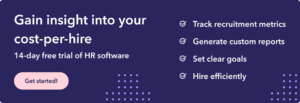The recruitment process is never as simple as it seems. Setting up a budget for hiring new talent is essential in a company, and this hiring cost is known as the cost per hire. Because this cost can add a lot to your company’s bottom line, it is important to consider how much is the company willing to spend in order to fill a position.
Many factors need to be considered in order to come up with a reasonable budget for a company’s expenses and compensation for new hires.
As part of our series on key HR metrics, we’ll explore cost per hire here. The cost per hire is a widely used metric that allows organizations to see how much their company is spending to fill an open position. We will look at what the cost per hire is, as well as how to optimize it.
- What is cost-per-hire?
- Why is the cost-per-hire metric important?
- Does cost-per-hire work?
- What should be included in hiring costs?
- What factors influence your cost-per-hire?
- Add up your internal costs
- Calculate external costs
- What is a good recruiting cost?
- Finding the cost-per-hire average?
- How to use CPH?
- Improving your cost-per-hire
- Cost-per-hire: FAQs
What is Cost-Per-Hire?
Cost per hire (CPH) is one of the most commonly used metrics to verify the hiring and recruiting process quality. It includes the total cost of incorporating any new employee into the company. Consequently, the parameters include costs like recruitment expenses, travel costs, administrative costs, benefits, and equipment.
Although it is a vital metric, the standard formula to calculate the metric only came up by 2012. The American Standards Institute and the Society of Human Resources Management together describes cost per hire formula as
CPH=(Internal Recruiting Costs + External Recruitment Costs) / Total Number of Hires
Having a high CPH may help streamline your selection process however there are ways to streamline hiring without spending so much. Looking into CPH can help you identify the investments and expenses the organization makes for candidates.
Why is the Cost-Per-Hire Metric Important?
No recruitment metric tells the full story. It is crucial that organizations focus on Key Performance Indicators (KPIs) that work for them and put them together to see the whole picture. Why consider CPH?
- All companies need to hire new talent. Calculating cost per hire helps provide insight into a vital process. While most organizations already track costs for their recruitment processes, CPH encourages them to pay attention to the details, even small, hidden expenses. Irrespective of whether it is internal or external, this can improve your recruitment visibility.
- It helps in budgeting and planning out strategies for future projections.
- It acts as a performance benchmark for the hiring team.
- Facilitates the optimization of expenses and resources, making the hiring process more efficient.
CPH is not simply about whether the organization is spending too much.
Perhaps you may find that the hiring process is not spending enough to hire the right candidates. Reviewing CPH can reveal the best-performing strategies for finding the right fit for the role. Reducing the CPH simply because it is a cost metric may mean failing to take advantage of the resources which attract the right candidate. This can prove to be fatal in the long run.

Does Cost-Per-Hire Work?
Companies that use CPH have a much better chance of adhering to the budgets they create. While CPH is a great start, it is not wise to use it as a standalone metric.
CPH allows companies to gain an understanding of their spending, but organizations need to pair it with other metrics like time to hire, to truly understand what it means. This helps companies optimize their hiring process and get a much better and efficient recruitment process. Reducing the CPH is not necessarily the best course of action.
What Should Be Included in Hiring Costs?
Identifying what constitutes the hiring costs is crucial to understanding CPH. This includes taking into account internal and external costs, along with any hidden costs. You need to consider travel costs, accommodation, the cost of running recruitment drives, and even recruitment bonuses.
What Factors Influence Your Cost-Per-Hire?
Several factors play a key role in influencing your organization’s cost per hire. While these may differ from one company to the other, the skeleton framework for setting a budget remains constant.
The main factors that determine your CPH are:
1. Industry
CPH varies from one industry to the other. Companies within an industry have similar market pressures, constraints, and workplace demographics.
This means that what may seem to be a high CPH for one industry is a moderate one for others. For example, the average CPH for banking and financial services is around $4323, while the same is $5611 for the manufacturing industry.
2. Staff Size
Larger organizations enjoy lower CPH when compared to smaller companies. For example, the CPH for all positions is at an average of $3976 across companies. However, this is distributed as large companies having a CPH of $3202, while midsize companies spend $5380 per hire.
This is mostly due to the resources available to larger organizations. Small and midcap businesses do not hire much and often fail to have a dedicated budget for hiring. Counterintuitively, this makes each hire more expensive.
Larger companies also boast a much more efficient hiring process, with a lower time to fill. This makes for lower CPH.
3. Location
Location plays a major role in determining your CPH. Companies in larger cities with bustling life almost always tend to have better access to a varied pool of talent. This includes people who have shifted to the city for better job prospects.
This makes it easier for such organizations to access candidates. Companies in more remote locations will have to spend more on travel, arrangements for stay, and hiring bonuses. This makes for a much higher CPH.
4. Position Level and Types
The position level and type play a major role in deciding your CPH. Executive positions cost significantly more to fill than entry-level ones. Similarly, positions that do not require extensive training or experience also have lower CPH in comparison to those that do.
This is mostly due to the extensive interview, multiple levels of selection and screening, and staff involvement required for the positions. The Society for Human Resource Management places the CPH average at $4,425, while that for executive positions is approximately $14,936.
It would be best to draw out budgets for each level that your organization is hiring for and then determine the best fit.
Other factors include the type of recruitment process you have, signing bonuses offered to candidates and candidate experience. Coupling CPH with other factors gives you the best strategy to follow to optimize your CPH while gaining access to the best in the talent pool for your region.
Add Up Your Internal Costs
Having a fair idea about your internal costs will ease the calculation of CPH. This includes factors like
-
Recruiter’s salary
-
Interview Cost
-
Referral Bonus
-
Recruitment Technology
-
Work Environment and other resources
Calculate External Costs
Identify the external costs that go towards contributions outside your office. This makes up an important chunk of CPH
-
Advertising cost
-
Recruiting Software
-
Recruiting Fees
-
Agency Fees
What Is a Good Recruiting Cost?
There is no one size fits all formula to finding the right CPH for your organization. The Society for Human Resource Management places the CPH average at $4,425. Comparing your CPH with industry standards and averages gives you a fair idea of what your CPH should be to stay in the competitive hiring market.

How to Find the Cost Per Hire Average?
Cost per Hire average is a great way to identify the right parameters and set a budget. Just calculate your actual recruiting expenses from the previous year and divide this by the total number of hires you made in that year. This gives you the cost per hire average.
Once you arrive at this number, multiply this number by the number of hires you intend to make this year. This will give you the intended budget for this year’s hires.
You will undoubtedly need to fine-tune this by taking into account any extra costs, job board fees, and so on. However, this will give you a ballpark estimate, and help you plan your recruitment process accordingly. A projection and comparison to industry standards is a great way to move forward.
How to Use CPH?
It is not just enough to arrive at a number for CPH. It is equally important to identify how you can use this metric to optimize your recruitment process. Here are some things that will help you make the best use of your CPH insights:
1. Track it Overtime
Tracking your CPH over time allows you to look for any irregularities. It also acts as a feedback loop, allowing you to assess the recruitment decisions made in years, relate them to CPH, and see their effects on the hiring process.
2. Calculate it for Individual Department
Identifying the CPH per department and position can help you arrive at conclusions that can reduce CPH or increase it if necessary. Comparing it to industry standards for the same departments in your industry could lead to better decisions. It also helps you identify if your CPH is competitive.
3. Estimate Your Cost Per Hire for Future Spendings
A great way to identify costs and set a budget is to estimate your CPH beforehand. This helps limit future spending and unexpected costs. The best way to do it is by fixing an estimate on the number of candidates you wish to hire in each department.
Once this is done, identify the cost per hire average for each of the departments and multiply this with the estimated hires in the respective areas. Add this up and account for any potential additional costs.
4. Evaluate it With Other Metrics
CPH by itself does not offer any major insights. It is vital to pair it up with other metrics such as time to hire, time to fill, or quality of hire to identify opportunities to optimize your hiring process. This will also ensure that you have access to the best candidates, as it boosts the candidate experience, making your organization a coveted workplace. It is also important to check your metrics with those of your competitors.
By pairing other metrics, you also gain information that helps you better your recruitment while also reducing your cost to hire.
How to Improve Your Cost Per Hire?
While you want to keep costs low, it is important that you also utilize available resources to make sure you are hiring the best possible candidates. Here are a few ways you can improve the cost per hire metric while optimizing your recruitment:
1. Employee referrals
Employee referrals can improve the recruitment process, ensuring that a smoother recruitment process at a lower cost to the business. This can be encouraged by incentivizing your employees to refer others fitted for a role to the company. It also helps in creating a good employer brand.
2. Talent Pools
If you can develop a good talent pool with a handful of potential applicants, you significantly lower the need to go over the entire recruitment pipeline every time there is a role to fill. This also eliminates the need to start from scratch. A talent pool with applicants familiar with your employer brand and organization can be an asset in the future and can significantly ease the recruitment timeline, leading to lower CPH and time to fill.
3. Group Interviews
Group interviews are not only a great way to screen candidates applying for a role, but it also reduces the CPH. You have the opportunity to assess candidates in batches, reducing a lot of overall expenses.
4. Outsourcing
Outsourcing the recruitment process ensures that you do not spend unnecessary time and resources trying to find the right candidate for the job. This can lower the CPH while still ensuring you get the best candidate. External companies also have a talent pool to browse from, so you will not be starting from scratch.
5. Recruitment software
Recruitment software helps identify, screen, and assess candidates, gives them timely information about your hiring process, and eliminates unnecessary costs. A great applicant tracking system can save both time and money without compromising on quality.
6. Social Media
A lot of people depend on social media for new opportunities. This is great news for recruiters, as social networks are mostly free to use, or require very little investment. This allows you to scout for talent without the high costs involved.
FAQs
1. What was the average cost-per-hire in 2020?
The average CPH is $4000 per employee, across workplaces and industries.
2. What is included in cost-per-hire?
The cost per hire metric includes internal costs, paid within a company, like a recruiter’s salary, as well as external costs that are paid to those outside the company. The former includes the recruiter’s salary, the cost of the interview, the cost of technology used, and so on – while the latter includes accommodation and travel expenses, advertising costs, and third-party costs borne by the organization.
3. How do you calculate CPH?
The CPH formula is:
(Internal Recruiting Costs + External Recruitment Costs) / Total Number of Hires









Thanks for sharing this blog. A hiring benchmark is a standard or point of reference against which your candidates can be compared or assessed. Benchmarking creates a profile of the ideal candidate for your open position.